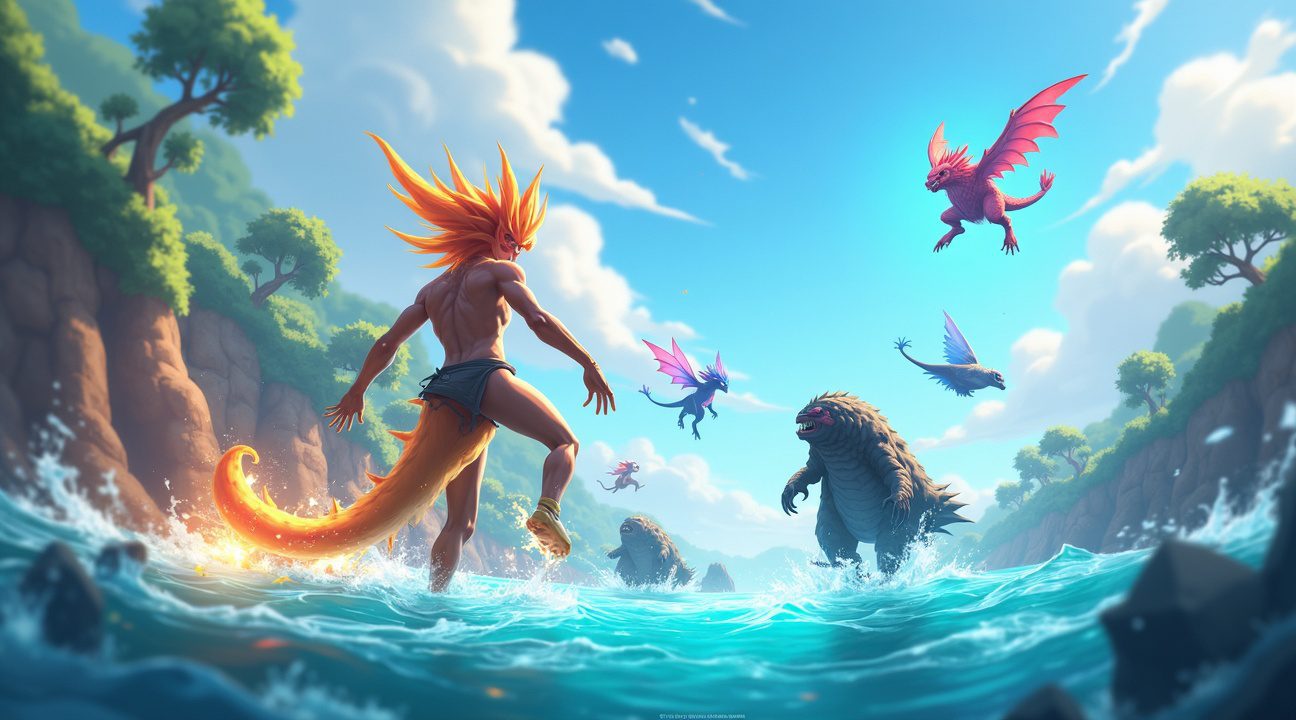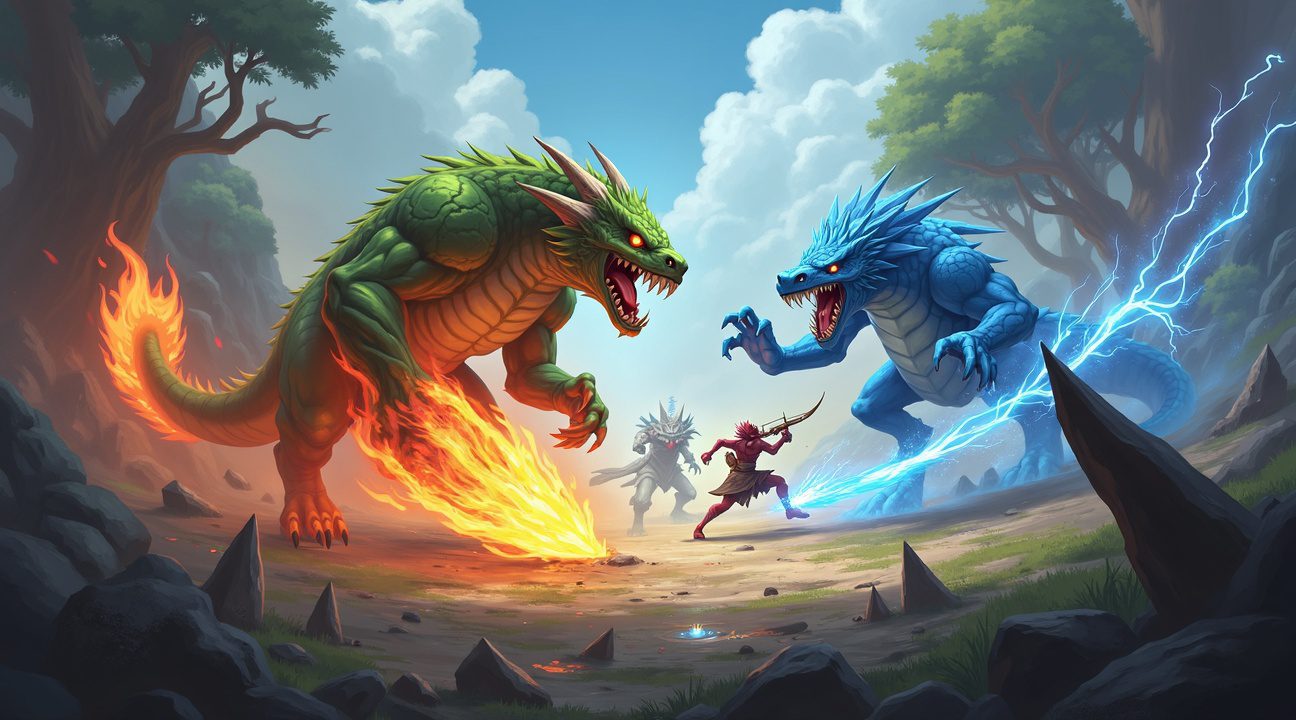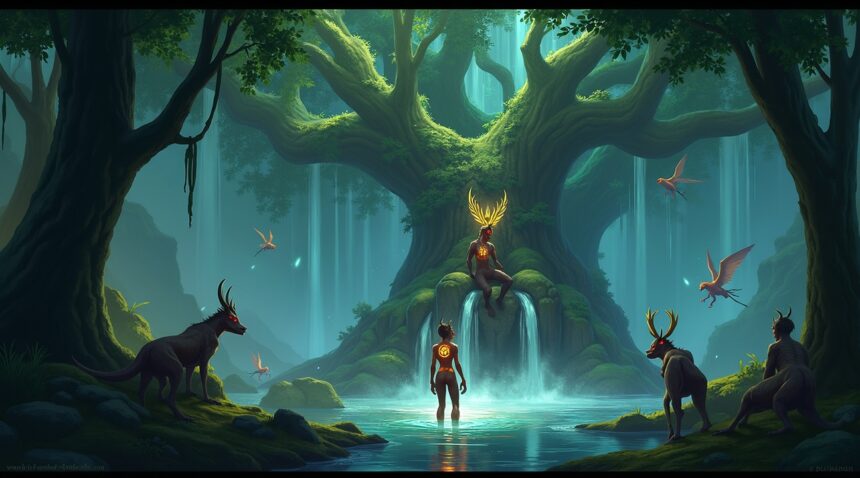Aniimo’s latest trailer showcases the revolutionary “Twining” mechanic that allows players to merge directly with their captured monsters. This fusion transforms the traditional monster capture experience into something entirely new.
The upcoming free-to-play open-world game, Aniimo, aims to redefine the creature-collection genre with innovative systems that bring together real-time combat, immersive environments, and RPG elements into a seamless adventure. Below are the major highlights featured in the trailer.
Key Takeaways
- Revolutionary Twining System – Players can merge directly with their captured Aniimo creatures, gaining access to unique abilities, movement options, and combat styles that vary dramatically based on each creature’s characteristics.
- Real-Time Combat Evolution – The game abandons traditional turn-based battles in favor of fast-paced, action-oriented combat that leverages elemental matchups, energy management, and strategic use of positional advantages.
- Deep Collection Mechanics – Each creature features distinct personality traits that affect combat performance and stat growth. Players can enjoy rich progression systems that include research trees, evolutions, and customizable skill loadouts.
- Dynamic Open World – The world of Idyll offers seamless biome transitions, creatures reacting dynamically to changing weather, and puzzles that require strategic deployment of creature abilities for progression.
- Cross-Platform Launch – Aniimo is scheduled for release in 2026 across Xbox Series X|S, PC, and mobile platforms, with a closed beta starting in late summer 2025 for players who pre-register.
With its novel approach to player-creature interaction through “Twining,” and a world that responds to both players and their companions, Aniimo is poised to offer a genre-defining experience for action RPG and monster-collection fans alike.
Revolutionary “Twining” Mechanic Transforms Monster Capture Gaming
Aniimo breaks new ground in the monster capture genre with its groundbreaking “Twining” mechanic, a feature that completely reimagines how players interact with their captured creatures. Unlike traditional games where trainers remain separate from their monsters, Twining allows players to merge directly with their Aniimo, essentially becoming the creature itself.
This isn’t a simple cosmetic change or temporary power boost. When players activate Twining, they experience a complete transformation that affects every aspect of gameplay. The camera perspective shifts, combat mechanics change entirely, and environmental interactions open up new possibilities that weren’t available in human form. This creates an entirely different gaming experience from what fans expect in monster capture titles.
Dynamic Combat and Exploration Through Transformation
The Twining system offers several key advantages that revolutionize both combat and exploration:
- Direct control over powerful Aniimo abilities without the delay of command inputs
- Access to creature-specific movement options like flight, swimming, or burrowing
- Environmental interactions that match each Aniimo’s natural abilities and size
- Combat styles that vary dramatically based on the merged creature’s characteristics
- Strategic depth through real-time switching between human and Aniimo perspectives
Players can seamlessly transition between commanding their creatures from a distance and taking direct control through Twining. This flexibility means combat encounters become far more dynamic than traditional monster capture games allow. Instead of issuing commands and waiting for responses, players can instantly adapt their approach by switching forms mid-battle.
The mechanic also transforms exploration mechanics significantly. Different Aniimo provide access to previously unreachable areas—aerial creatures unlock new vertical paths, aquatic forms open underwater regions, and smaller creatures might access tight spaces that larger forms can’t enter. This design philosophy encourages players to collect diverse Aniimo not just for combat effectiveness, but for the unique exploration opportunities each transformation provides.
What makes Twining particularly innovative is how it maintains the strategic elements of traditional monster capture while adding direct action gameplay. Players still need to consider type matchups, elemental weaknesses, and tactical positioning, but they can execute these strategies with the precision and immediacy of direct control. The system bridges the gap between turn-based strategy and real-time action in a way that feels natural rather than forced.
Recent gaming developments have shown how fighting game innovations can influence other genres, and Aniimo’s approach suggests similar cross-pollination between monster capture and action gaming. The Twining mechanic represents a fundamental shift in how developers approach creature-based gameplay, moving beyond the traditional trainer-pet relationship into something more symbiotic and immersive.
This transformation system also affects character progression in meaningful ways. As players spend time Twined with different Aniimo, they gain deeper understanding of each creature’s capabilities and limitations. This knowledge translates into better strategic decisions when commanding creatures in traditional mode, creating a feedback loop between the two gameplay styles.
The technical implementation appears sophisticated enough to handle rapid transitions between human and creature forms without breaking immersion. Players can experiment with different combinations during encounters, switching between forms as tactical situations demand. This flexibility ensures that no single approach dominates gameplay, encouraging creative problem-solving and adaptability.
Aniimo’s Twining mechanic positions the game as a potential genre-defining title that could influence future monster capture games. By allowing players to literally step into their creatures’ shoes—or claws, or wings—the game creates an emotional connection and gameplay depth that traditional command-based systems struggle to match. This innovation might inspire other developers to reconsider the fundamental assumptions about how players should interact with captured creatures in their own projects.

Real-Time Combat System Redefines Creature Battles
Aniimo breaks away from conventional monster capture games by implementing a fast-paced, real-time combat system that eliminates the static nature of turn-based battles. I find this approach refreshing since it demands constant engagement and split-second tactical decisions from players. The system allows seamless switching between creatures and combat styles without any cooldowns, creating fluid battles that feel more like action RPGs than traditional creature collectors.
Combat Stats and Damage Mechanics
The combat framework revolves around six core statistics that determine battle outcomes. Combat power serves as the primary indicator of a creature’s overall strength, while physical and magical attack and defense values dictate damage output and mitigation. Speed affects action timing and initiative, and critical hits deliver devastating 1.5x damage multipliers that can turn the tide of challenging encounters.
Elemental matchups form the strategic backbone of combat encounters. Fire-type creatures dominate grass opponents, while water-based attacks prove devastating against lightning elementals. I appreciate how these relationships force players to carefully consider their creature selections before engaging different enemy types. The system rewards tactical thinking while maintaining the accessibility that newcomers expect from the genre.
Energy management adds another layer of strategic depth to each battle. Ultimate attacks require careful resource allocation since they recharge based on damage dealt rather than time elapsed. This mechanic encourages aggressive playstyles while preventing players from relying solely on powerful abilities to secure victories.
Skill Categories and Environmental Tactics
Aniimo organizes creature abilities into distinct functional categories that define battlefield roles. The classification system includes several key types:
- Dodge skills that provide evasive maneuvers and repositioning options
- Heal abilities for sustaining creatures throughout extended encounters
- Shooter attacks that deliver ranged damage from safe distances
- Shield techniques that absorb incoming damage and protect allies
- Specialized combat abilities that exploit specific environmental conditions
Environmental positioning significantly impacts skill effectiveness, creating dynamic battlefields where terrain matters as much as creature selection. Flying creatures demonstrate this principle perfectly — they naturally dodge ground-based attacks but become vulnerable to ranged threats. This positioning system transforms simple creature matchups into complex tactical puzzles where placement and timing determine success.
The real-time nature means battles flow continuously without artificial pauses for menu navigation. Players must react instantly to changing conditions, whether that involves switching creatures to counter unexpected threats or repositioning to exploit environmental advantages. Fighting game mechanics clearly influence this design philosophy, bringing precision timing and spatial awareness into the monster capture genre.
Combat encounters become increasingly sophisticated as players progress through the game world. Early battles might focus on basic elemental matchups and simple skill execution, but advanced encounters require mastery of energy management, environmental exploitation, and rapid creature swapping. The system scales beautifully from accessible entry-level play to demanding endgame challenges that test every aspect of a player’s tactical knowledge.
This real-time approach represents a significant evolution for monster capture games, moving beyond the methodical pace of traditional systems into territory that demands constant engagement and rewards skillful execution.

Deep Creature Collection and Progression System
Personality-Driven Combat Mechanics
The Aniimo collection system introduces a sophisticated approach to creature capture that goes far beyond simple acquisition. Each creature comes with distinct personality traits that directly influence their combat effectiveness and statistical growth. Timid Aniimo might excel in speed but struggle with offensive capabilities, while aloof creatures often develop stronger defensive characteristics at the cost of team synergy. Practical Aniimo typically offer balanced stat distributions, making them excellent choices for new players learning the system. Obedient creatures respond better to training commands and often achieve higher HP thresholds, though they may lack the unpredictable advantages that come with more independent personalities.
These personality systems create meaningful choices during the capture phase. I’ve found that understanding how each trait affects long-term development helps players build more effective teams. Speed-focused builds benefit from timid creatures, while defensive strategies work best with aloof Aniimo that naturally develop higher defense ratings. The personality system ensures that identical species can play completely different roles depending on their individual characteristics.
Advanced Progression and Customization Options
The progression framework offers multiple pathways for developing captured creatures through upgrading, research, and evolutionary advancement systems. Research mechanics allow players to unlock new abilities and enhance existing traits through dedicated study sessions. Development options include:
- Stat boosting
- Skill refinement
- Trait modification
This gives players substantial control over their team’s growth trajectory. Evolutionary advancement represents the pinnacle of creature development, fundamentally transforming Aniimo into more powerful forms with expanded capability sets.
Rarity tiers add another layer of strategic depth to collection efforts:
- Common: Accessible and ideal for newcomers
- Rare: Better base stats and unique abilities
- Perfect-tier: Exceptional stats with powerful trait combinations
The rarity system encourages continued exploration and creates exciting discovery moments during gameplay sessions. Players can invest time developing lower-tier creatures or focus their efforts on acquiring rare specimens that offer immediate advantages.
Trait systems complement the personality mechanics by providing passive abilities that activate automatically during combat encounters. These passive skills range from elemental resistances to stat bonuses that enhance specific combat roles. Active skills divide into elemental attacks and support abilities, allowing players to craft diverse tactical approaches. Elemental skills provide direct damage options with type advantages, while support abilities focus on healing, buffing, and battlefield control.
Team and skill loadout customization ensures players can adapt their strategies for different scenarios. Combat loadouts emphasize offensive capabilities and type coverage, while exploration builds prioritize utility skills and environmental navigation abilities. The loadout system allows quick switching between configurations without permanent commitment, encouraging experimentation with different tactical approaches. This flexibility proves particularly valuable when facing varied challenges across the open-world environment, similar to how players adapt strategies in other monster capture games like those featured in fighting game announcements.
The combination of personality traits, rarity tiers, and customizable progression creates a collection system with remarkable depth. Players can pursue completionist goals by capturing every available species while simultaneously focusing on optimizing their core team through strategic development choices. This dual-path approach ensures both casual collectors and competitive players find engaging progression opportunities that match their preferred playstyle preferences.
Immersive World of Idyll Features Dynamic Exploration
I believe Aniimo’s world of Idyll represents a significant leap forward in open-world design, creating a seamless environment where every biome feels distinct yet interconnected. The game showcases floating cities that drift through crystalline skies, volcanic zones crackling with elemental energy, vast oceanic depths teeming with aquatic creatures, and lush forests where sunlight filters through ancient canopies. Each biome isn’t just a visual backdrop but functions as a living ecosystem that responds to player actions and environmental changes.
Dynamic Environmental Systems Shape Gameplay
The time-of-day and weather systems create meaningful gameplay variations that extend far beyond cosmetic changes. I’ve observed how creature behavior shifts dramatically based on these conditions—certain nocturnal Aniimo emerge only during rainy nights, making their discovery feel like genuine exploration rather than simple collection. This reactive ecosystem means players can’t rely on static spawn patterns or predictable encounters.
Weather patterns influence more than creature availability:
- Rainfall might reveal hidden pathways or activate dormant plant life.
- Volcanic eruptions can temporarily reshape terrain and create new traversal opportunities.
These dynamic elements ensure that each return visit to familiar areas offers fresh discoveries and challenges.
Elemental Powers Drive Creative Problem-Solving
Environmental traversal connects directly to the elemental abilities derived from captured Aniimo, creating a progression system where new creatures unlock new exploration possibilities. Players harness:
- Fire powers to melt ice barriers or ignite dormant machinery.
- Wind abilities to activate ancient mechanisms or create temporary bridges across chasms.
- Water-based powers to extinguish flames or reveal hidden passages beneath waterfalls.
The physics-based puzzle design encourages creative experimentation with these elemental combinations. I find this approach refreshing compared to traditional key-and-lock progression systems. Instead of simply finding the right item, players must understand how their Aniimo’s abilities interact with environmental elements. For example:
- Cool lava flows with water powers.
- Use wind abilities to clear toxic gases.
This creates multi-step solutions that feel intellectually satisfying.
This interconnected design philosophy extends to creature interactions within their environments. Fire-type Aniimo thrive in volcanic regions but struggle in aquatic zones, encouraging players to maintain diverse teams and think strategically about which creatures to deploy in different biomes. The trailer reveals glimpses of these elemental interactions in action, showcasing how players can leverage environmental advantages during both exploration and creature encounters.
Idyll’s seamless world design eliminates traditional loading screens between biomes, allowing for natural transitions that feel organic rather than artificial. Players might dive from floating cities into deep ocean trenches or climb from forest floors to volcanic peaks without interruption. This continuity enhances immersion and makes the world feel genuinely expansive rather than segmented.
The reactive nature of Idyll’s ecosystem creates emergent gameplay moments that can’t be scripted or predicted. Environmental changes might temporarily block familiar routes, forcing players to discover alternative paths or wait for conditions to shift. These systems encourage patience and observation while rewarding players who pay attention to environmental cues and patterns.
Aniimo’s approach to world design demonstrates how modern technology can create living, breathing environments that respond meaningfully to player presence. Each biome serves multiple gameplay functions—as creature habitats, puzzle venues, and traversal challenges—creating a cohesive experience where exploration feels purposeful and rewarding. The integration of elemental powers with environmental mechanics ensures that progression feels earned through understanding and experimentation rather than simple time investment.

Genre-Defining Position Among Monster Capture Games
Aniimo establishes itself as a groundbreaking entry in the monster capture space by merging familiar gameplay elements with innovative mechanics that push the genre forward. The game draws clear inspiration from established franchises while carving out its own distinct identity through advanced systems and next-generation features.
Blending Iconic Gameplay Elements
The creature collecting mechanics immediately bring Pokémon to mind, offering players the satisfaction of discovering, capturing, and building teams of unique monsters. However, Aniimo takes this foundation and expands it through an open-world design reminiscent of The Legend of Zelda series. Players can explore vast landscapes without traditional boundaries, discovering creatures in their natural habitats rather than through random encounters or fixed locations.
This combination creates a more immersive experience where monster discovery feels organic and exploration-driven. This approach is particularly compelling because it addresses one of the main limitations of traditional monster capture games — the disconnect between exploration and creature collection. Much like how GTA 6 promises to revolutionize open-world gaming, Aniimo appears poised to transform how players interact with monster capture mechanics.
Revolutionary Combat and Transformation Systems
Aniimo‘s real-time combat system represents a significant departure from the turn-based traditions that have dominated the genre for decades. The tactical battle system incorporates ARPG elements, allowing for dynamic encounters that require quick thinking and strategic positioning. This shift creates more engaging combat scenarios where player skill directly impacts battle outcomes.
The fusion mechanics add another layer of depth, enabling players to combine creatures for enhanced abilities and new strategic possibilities. These features work alongside the perspective-shifting transformation system, which allows players to experience battles from different viewpoints and potentially control their captured monsters directly.
These innovations address common criticisms of traditional monster capture games — namely repetitive combat and limited player agency during battles. The integration of these systems creates a more interactive experience that appeals to both longtime fans of the genre and newcomers expecting modern gaming conveniences. Similar to how Tekken 8 evolved fighting game mechanics, Aniimo appears to be pushing monster capture games into new territory.
The game’s position as a next-generation title becomes evident through its technical ambitions and design philosophy. By combining the collection appeal of traditional monster capture games with the freedom of open-world exploration and the excitement of real-time combat, Aniimo creates a hybrid experience that could define future entries in the genre. The free-to-play model also makes these innovations accessible to a broader audience, potentially expanding the genre’s reach beyond its traditional fanbase.
Release Timeline and Platform Availability
I’m excited to share that Aniimo fans won’t have to wait too much longer to dive into this ambitious creature-collecting adventure. The developers have confirmed a 2026 release window for this free-to-play open-world action RPG, giving the team ample time to polish the expansive monster capture mechanics and detailed environments showcased in recent footage.
Beta Access and Early Registration
Players eager to get their hands on Aniimo can mark their calendars for late summer 2025, when the closed beta launches. This testing phase will give select participants an early glimpse into the creature collecting systems and open-world exploration that define the game’s core experience. Pre-registration is already live, allowing interested gamers to secure their spot in line for beta access and potential launch bonuses.
Multi-Platform Launch Strategy
Aniimo’s accessibility across multiple platforms makes it particularly appealing for modern gaming audiences. The confirmed platform lineup includes:
- Xbox Series X|S for console players seeking high-performance gameplay
- PC for those who prefer mouse and keyboard controls or enhanced graphical settings
- Mobile devices for on-the-go creature hunting and collection management
This cross-platform approach ensures that players can engage with Aniimo’s monster capture mechanics whether they’re at home or traveling. The mobile version particularly stands out, as it opens up the possibility for continuous progression and creature management throughout the day. Given the recent success of other console gaming announcements, Aniimo’s multi-platform strategy positions it well in an increasingly competitive market.
The 2026 timeline also aligns with industry trends toward more polished free-to-play releases, suggesting the development team is prioritizing quality over rushed deployment. This approach has proven successful for similar titles that balance creature collection with open-world exploration, giving players confidence that Aniimo will deliver on its ambitious promises when it finally arrives.
Sources:
FunPlus, “Aniimo reveals new trailer at the Tokyo Games Show”
TheXboxHub, “Free-to-Play Creature-Collector Aniimo Comes with Unique ‘Twining’ Mechanic”
IGN, “Aniimo – Official Extended Reveal Trailer”
YouTube: “EVERYTHING You Need To Know About ANIIMO!”
XboxEra, “Aniimo got its inner furry on with a new trailer at Xbox’s TGS show”
YouTube: “Aniimo Review & Closed Beta First Impressions”
Aniimo Official Website


